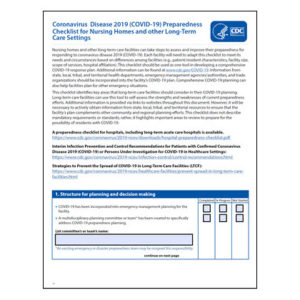7 Tips for Infection Prevention in Diabetes Care
Regular finger sticks and insulin injections offer a small but real chance of infection, but common sense protocols can reduce that risk.
Type 2 diabetes is one of the most common chronic conditions adults in America are likely to develop. According to the Centers for Disease Control and Prevention, more than 100 million Americans have diabetes or prediabetes, and more than a quarter of the population over the age of 65 have diabetes. Because it’s more common in older adults—the exact population more likely to live in long-term care and skilled nursing facilities—it’s estimated that about 25 to 34% of residents in these care facilities have diabetes. That’s a lot of people who may need ongoing help and support with diabetes management.
As more Americans age and head towards long-term care facilities, the number of long-term care facility residents with diabetes is only expected to grow, and in fall 2018, the American Diabetes Association released a position statement on how diabetes should be managed in long-term care and skilled nursing facilities. The ADA noted that simple yet personalized approach to managing blood sugar and insulin use is best.

Kim Elliott, senior vice president of clinical services at Brookdale Senior Living
But what about infection? Kim Elliott, senior vice president of clinical services at Brookdale Senior Living, a Tennessee-based senior living company with more than 800 facilities around the country, says that “generally, people living with diabetes are more susceptible to developing infections because high blood sugar can cause nerve damage and reduced blood flow to vulnerable parts of the body such as feet, lower legs, or pressure-sensitive areas. When blood flow is reduced, the chance for infection increases.”
In addition, “an individual with a weakened immune system is possibly more susceptible to infection when living in a communal living environment, such as assisted living or skilled nursing,” because there’s simply more people and potentially more germs and contact with other people in these spaces, Elliott says. “Therefore, nurses and caregivers in these settings regularly check for skin that is intact with no open areas such as cracks, blisters, or bruising in order to prevent the risk of infection.”
When it comes to testing blood sugars or administering insulin specifically, the CDC has published best practices guidelines for preventing infection or cross-contamination during blood glucose monitoring or the administration of insulin. These guidelines stipulate that:
- Fingerstick devices should never be used for more than one person.
- Blood glucose meters should also not be shared, but if they are, they should be thoroughly cleaned and disinfected after every use.
- Insulin pens and other syringes or cartridges should never be used for more than one person.
While some long-term care residents are able to check their own sugars and administer insulin injections themselves, some may need assistance with these routine tasks. Both groups of patients and their caregivers should be careful to follow the CDC and ADA guidelines to reduce the risk of infection.
As the CDC reports: “Outbreaks of hepatitis B virus (HBV) infection associated with blood glucose monitoring have been identified with increasing regularity, particularly in long-term care settings, such as nursing homes and assisted living facilities, where residents often require assistance with monitoring of blood glucose levels and/or insulin administration. In the last 10 years, alone, there have been at least 15 outbreaks of HBV infection associated with providers failing to follow basic principles of infection control when assisting with blood glucose monitoring. Due to under-reporting and under recognition of acute infection, the number of outbreaks due to unsafe diabetes care practices identified to date are likely an underestimate.”

Dr. Kathleen Dungan, endocrinologist at The Ohio State University Wexner Medical Center
While this might sound dire, Dr. Kathleen Dungan, an endocrinologist at The Ohio State University Wexner Medical Center, says that “overall, the risk of infection is extremely low,” but only “when the standard equipment is being used the correct way.” This means your staff need adequate training on how to use these machines. In addition, taking some simple additional measures can reduce the risk of infection or transference of blood-borne pathogens.
1. Wash your hands before and after every glucose check or insulin injection.
“We recommend that patients clean your hands before doing any finger sticks. That also helps prevent any interference with the glucose measurements,” Dungan says. It should go without saying that any clinician assisting a resident with these tasks should also wash thoroughly before making contact with the patient and again afterwards.
2. Disinfect pump catheter insertion sites before placing a new line.
Dungan says infections at the site of finger sticks are “incredibly rare, but we do sometimes see infections in insulin pump catheters. But even that is relatively uncommon, as long as they’re keeping the sites clean,” and as long as the site is properly disinfected with alcohol prior to the placement of the catheter tube. Take the extra time to swap the area completely to reduce the risk of infection.
3. Don’t share devices.
The bigger concern comes in when devices are shared, as often occurs in an institutional setting when one nurse or other care provider will assist several residents in succession. “There’s a pretty pervasive misconception that it’s safe to share glucose meters and glucose pens as long as you change the needle,” Dungan says. But “that’s not true. In particular, there’s a risk of spreading blood-borne diseases like HIV and Hepatitis B.” Because these diseases need only a tiny drop of blood to be transferred, “even a microscopic drop of blood left behind,” can become dangerous. “A lot of time you’ll see family members who share devices. But they should be very wary of doing this,” Dungan says. Again, appropriate training of staff on how to properly clean glucose meters and what can and can’t be reused is paramount. Staff should also seek to educate residents on how to properly use this equipment in a safe matter if they’re doing their own finger sticks and injections.
“In the case of insulin pens, one might think it’s perfectly safe to use the same pen. Most people know not to share insulin needles, but with a pen, you screw on a new needle,” each time, Dungan says. But, again, there’s “still a risk of contamination within that pen and there have been cases of transmission of HBV through the reuse of insulin pens. Even if you change out the needle, insulin pens should never be shared,” she says.
4. Create a routine diabetes management protocol and train your staff.
If you’re looking to improve the diabetes management protocol in your facility, Dungan recommends training for all staff members who may handle diabetes-related equipment and developing a standard approach to caring for people with diabetes. “At a minimum, washing your hands in an institutional setting,” is a smart place to start.
In addition, she says some facilities use a barcoding procedure to keep equipment organized and separate so there’s no accidental cross-use of pens or devices between patients. These safety precautions can “help the nurses or other staff recognize who should be getting an injection. It helps identify the right patient with the right medication,” which is a smart safety protocol from a dosing standpoint, too.
Other procedures such as putting the pen back in the patient’s drawer immediately after use and individually labeling all equipment can also take some of the guesswork out of which item matches with which patient and may help keep everyone safer. “Having a systematic protocol can help avoid infection,” Dungan.
5. Control blood sugars.
Elliott says that regardless of the specific type of infection, controlling blood sugars helps reduce risk. “The best way to prevent infections while living with diabetes is to control blood sugar levels. Diabetes education emphasizes an awareness of signs and symptoms of low and high blood sugar, the importance of maintaining a clean and healthy lifestyle, consisting of a well-balanced diet, regular physical activity, and routine visits with your physician or health care provider.”
6. Consider HBV vaccination.
Lastly, Dungan notes that the FDA is now recommending most people be vaccinated for Hepatitis B. “Most children are now being vaccinated, but there may be plenty of older patients who would also benefit from vaccination,” she says. The U.S. Department of Health and Human Services recommends adults age 65 and older get an HBV vaccine, which is administered as two or three injections over the span of a few weeks. Elliott also recommends seniors living in long-term care settings seek vaccination for a range of illnesses “Maintaining health by being proactive with immunizations such as flu vaccine, pneumococcal, or others as recommended helps to reduce the vulnerability to infection.” (Medicare Part B and Part D plans typically cover the HBV, flu, and pneumonia vaccines.)
7. Treat the whole person.
As a parting thought, Elliott adds it’s important to see the whole person, rather than just a diabetes patient. “Residents are not defined by their disease and have the right to make choices regarding their care. As health care providers working with seniors, we have the responsibility to provide education and other resources as the resident navigates their journey toward wellness and life balance. Residents living in assisted living or skilled nursing centers are adults who have strengths, knowledge, and are empowered/capable of making choices about managing their diabetes regardless of whether we agree or not with those choices.”

Elaine K. Howley is a freelance journalist for various publications. An award-winning writer specializing in health, fitness, sports and history, her work has appeared in numerous print and online publications, including U.S. News, AARP.org, espnW, SWIMMER magazine and Atlas Obscura. She’s also a world-record holding marathon swimmer with a passion for animals and beer. Contact her via her website: elainekhowley.com.
Related Articles
Topics: Clinical , Featured Articles , Infection control , Resident Care











